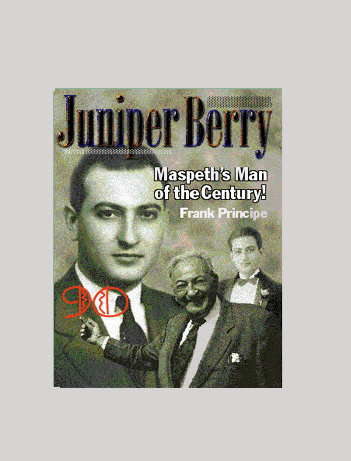Many a harried straphanger riding the 'M' line, the enduring steel thread linking Manhattan's skyscrapers with Middle Village's sea of red brick houses, may not be aware that this line was once a steam railroad, known as the Lutheran Line, which had locomotives small enough to fit into a garage.
In the years before unification (1898) Brooklyn was an independent city with it's own horsecar and elevated railway system. A means of transportation was sought for Brooklyn visitors to the newly opened Lutheran Cemetery (1852) in Middle Village, Queens. The Bushwick Railroad management secured land for a depot site at the intersection of Wyckoff Avenue and Palmetto Street, a busy transportation hub with six horsecar lines plus the Myrtle Avenue elevated terminating there. By the end of February 1881, the Bushwick Railroad had obtained a right of way to the cemetery gates, passing through the former farms of Nickolas Wyckoff, Joachim Meyerose, Mr. Doscher and the Wagner brothers. By December 1880, the company had secured land on the South side of Metropolitan Ave. between what was then Wendel's Hotel on the west and John Sutter's marble works on the east, the present 'M' line terminal site. The steam dummy, a locomotive about twenty four foot long with a vertical boiler was selected for motive power. While unsatisfactory in city streets it was suitable for suburban service where cinders were not a problem. Furthermore the steam dummy was not subject to heat or diseases and best of all could pull tow or three coaches with just one operator. The Cypress Hills Cemetery Line opened by the Bushwick Railroad in 1878 was a success using steam dummies. The Bushwick Railroad Management expected the Lutheran Line, having conditions similar to the Cypress Hills Line to be equally successful using steam dummies.
The Lutheran Line opened on Saturday, September 3, 1881. About one hundred people were on hand for the opening ceremonies. The initial run was made by a train of two brightly painted red coaches. It left the Myrtle – Palmetto depot at 4:00 PM, completing the mile and a half run eight minutes later. The fare was five cents for adults and three cents for children. The Lutheran line was a success from the beginning, three coaches were often required during peak load periods, Sunday and holidays. However, the age of lilliputian steam railroading was short lived. Charles Van DePoele's electric trolley installation opened on Jamaica Avenue, December 17, 1887, and proved to be superior to the horsecars. One by one horsecar and steam dummy lines in Brooklyn were replaced by electric trolleys. Finally, on August 3 or 4, 1895, the Lutheran Line received trolleys. With the passing of steam dummies from Lutheran and Cypress Hills on October 27, 1895, a colorful era of Disney like steam railroading in Western Queens had passed.
In the years to follow the Lutheran Line would be incorporated into the behemoth BMT subway-elevated system, as part of the Myrtle Avenue “EL” which was extended to Metropolitan Avenue, receiving the designation “M” in 1967. The “M” Line still uses the portion of the original Lutheran Line ground level right of way beyond Fresh Pond Road to reach Metropolitan Avenue.
Ending it's run near Christ the King High School, located on the grounds of Lutheran (All Faiths) cemetery, the “M” Line is ecumenical and no dummy.
Though the Lutheran Line opened rather late in the season, it was a big success. The new equipment, the speed of service and the novelty of the dummy attracted many patrons. Many cemetery visitors, disgusted with the undependable service on the Metropolitan Avenue horse car, and the old, dirty cars flocked to the dummy as a faster and more comfortable mode of travel. There was only one complaint. Passengers had to pay 5 cents while the Cypress Hills passengers only paid 3 cents. Nevertheless, accommodate the traffic.
On February 4, 1882 a heavy snow storm hit Long Island which the winds piled up into drifts. The Lutheran dummy was shut down for 4 days. When the snows got too deep, passengers were carried in the dummy itself. Such service was appreciated and received editorial praise: “The dummy line between Ridgewood and Middle Village is accommodating to a degree that excites admiration….The steam cars have made occasional delays but the time made has been more regular than might have been expected…had it not been for the dummy line, Middle Village would have been cut off from the outside world.”
On August 1,1888 the Brooklyn City Railroad took over the Bushwick Railroad Company and on August 3, 1895 they converted the Lutheran Line to electric trolley cars which were less expensive to operate.
In 1979 the old station was torn down and modernized. The Middle Village El Station has been in service for 118 years.
It was remarkable how these pygmies raced along, rivaling the giant locomotives in speed. It was reported that the Lilliputian engines were finally sold to South American countries where, even today, some are said to be still in service.


